It's great to be out here with you.
I'll tell you what: you're wandering around the lobby at 5:30 and all the people from the East Coast who couldn't sleep are looking for coffee and the gym. There's a lot of energy in this place.
As Sully [General Gordon Sullivan] said, I'm here for a reason. I'm here because what you do is so important to the long-term health of this force and to our ability to hold this force together and put it back in balance over the next several years. I felt it very important for me to come down here and give you the context that you're going to be operating in...and implementing this campaign plan in.
So I'd like to talk to you about three things. One, how we're doing. I'm just finishing up another round of Congressional posture hearings, so I just wanted to give you a sitrep about where we are and what I gave to Congress. Then I want to talk to you about where we're going over the next years, the things we're going to do in the next year that are going to affect us well down the road. Lastly, I want to talk to you about thinking fundamentally differently about how we operate because we will be operating fundamentally differently than we were five or ten years ago. And those of you who are waiting to get back to the good old days -- we're never going back. So we are in a period of continuous and fundamental change, and I think it's important for us all to grasp that as you go forward and implement this campaign plan.
So those are the three things I want to do today. I think I told my Sergeant Major joke already so I'm not even going to try it here today. Okay, maybe I will. [Laughter]
There was a Sergeant Major, an Apache pilot and a General. They're all in this prisoner of war camp. The Commandant came in one day and he got them all together and he said, "I've got bad news. Tomorrow at dawn you'll face a firing squad, but I'm here to grant you your last wish." He looked at the Apache pilot and said, "Major, what's your last request'" He says, "I want to have dinner by candle light with a beautiful woman." He said, "It will be done."
He goes to the General who sucks himself up to his full height of 5'9". [Laughter] And he says, "I want to address the troops one more time." He said, "It will be done."
He goes to the Sergeant Major. He says, "Sergeant Major, what's your last request'" The Sergeant Major says, "I want to be shot an hour before the General starts talking." [Laughter]
I hope you don't feel that way. [Laughter]
Anyway, how are we doing'
[Hooahs].
Good. I'm going to answer the question for you now: how we're doing' This is what I told Congress:
Back in 2007, I was wrestling with trying to describe the condition of the Army. I was hearing it was broken. I was hearing it was hollow. I was hearing it wasn't that good. And as I went around the Army with Sheila [Casey], looking at things and getting direct feedback from Soldiers, Civilians, Families, it was clear to me that while we weren't broken and hollow, we were stretched. So I came up with the term that we're "out of balance." We're so weighed down by the current demands that we could not do the things that we know we need to do to sustain this force for the long haul and prepare to do other things. So, in 2007, we put ourselves on a plan centered on four imperatives to put ourselves back in balance by '11. I will tell you-and the report I gave to Congress is-we have made great progress toward those objectives, and with the '11 budget that we just presented to the Hill, and the drawdown in Iraq, we are going to come very, very close to meeting all the objectives (we set for ourselves in 2007) by the end of 2011.
Now, the four imperatives: Sustain Soldiers and Families; continue to Prepare Soldiers for success in the current conflict; Reset them effectively when they come home; and continue to Transform for an uncertain future.
You can see that IMCOM has a direct role in each of those.
A quick step back: On the objective of getting back in balance. First is growth. Some of you will recall-in January 2007-we were told to increase the size of the Army by 74,000 -- 65,000 in the Active force, and the rest in the Guard and Reserve. Originally we were going to complete that in 2012. One of the first things I did when I got here was to go to Secretary [of Defense] Gates and asked that we move that forward to 2010. We actually finished it last summer. We finished our growth three years ahead of time. And, I'll tell you, it wasn't a moment too soon with the plus-up in Afghanistan.
Second is dwell-the time Soldiers are at home. I will tell you after almost three years in the job now, it's clear to me that the most important thing we can do to restore balance to the Army is to increase the time the Soldiers are at home. Not just so they can spend more time with their Families-although that's important-but so they can recover themselves. Last year, we completed a scientific study that told us what we had to do: ... it takes two-to-three years to recover from a one-year combat deployment. And when you're churning like we have been at one year out--one year back, you don't have time to fully recover.
We are well on our way to meeting that. And even with the plus-up in Afghanistan, we will get 70 percent of the Active force dwell to two years at home by '11, and 80 percent of the Guard and Reserve to four years at home by the end of '11. The rest will get there in 2012.
I'll tell you: I've been going around the Army, and when you see a unit that's got 18 months at home, it's light years different than having [only] 12 months at home. You can already see the impact. So we're making good progress toward that.
Third is modularity. In 2004, we began converting all 300 brigades in the Army to modular organizations. We're 90 percent done with that already, and we will largely complete it by 2011.
Next is Rebalancing-the next major element of organizational change. We are in the process of moving about 160,000 Soldiers from skills that were very necessary in the Cold War to skills more relevant today. For example, we have stood down about 210 companies, artillery batteries and air defense batteries, and we've stood up a corresponding number of civil affairs, psychological operations, Special Forces, and military police. That rebalancing will continue. We're about two-thirds of the way through that. We'll be done with that by the end of '11.
Taken together, modular organizations and rebalancing is the largest organizational change of the Army since World War II, and we've done it while we've been deploying 150,000 Soldiers over and back to Iraq and Afghanistan repeatedly. I don't have to tell you this, but that's a lot of moving parts. It's been hugely important to transforming ourselves into a relevant Army with the challenges we're facing.
The next subject near and dear to all of you is BRAC. You know what's going on with BRAC better than I do. But what I know from my level: 380,000 Soldiers, Civilians and Families are on the move, and a lot of it is happening in the next two years. And we'll probably publish a new phone book in a couple of years. After that, I'm not sure where everybody's going to be for the next two years. But the effort that has been made is going to allow us (1) to make that change with minimum turbulence, and (2) put us in a position where the quality of the facilities on our installations affected by BRAC will go up exponentially. I don't go on an Army installation these days without seeing cranes. It's hugely impressive. The work that you all have done to synchronize all the moving parts of that is just fantastic.
Lastly, putting ourselves on the rotational model-ARFORGEN, or Army Force Generation. We started this back in 2005; we put a well-thought-out, but conceptual, program on ARFORGEN. Because of demand, we were never able to implement it. Well, we are now getting to the point-with demand coming down in Iraq-where we can see a way ahead and we will publish within the next 60 days-the deployment schedules for '11, '12, and '13. I'm going to show you what that looks like here in a sec[ond]. That will lead folks to have one year out, two years back for the Active force; and one year out, four years back for the Guard and Reserve.
We have a much better chance of implementing that now than we did in 2005 when we first started. So we are moving to line all of our institutional systems up to support that model. I'll show you that in a second.
So how are we doing-by and large' I told Congress that we are making lots of progress. I can see how we'll get to the goals we set out in 2007. We're not out of the woods yet. And a lot of the things ... the outputs ... the outcomes for the last 8.5 years at war are going to be with us for a while. So just because we meet our goals in '11 doesn't mean that everything is going to be hunky dory. We're still going to be dealing with the challenges of the last 8.5 years of warfare for some time to come.
That's my status report to you. For the first time since I got here, I can see how we can get to the objectives that we've set for ourselves in '11. The money is there in the '11 budget, and it's a matter of executing now. We'll get to a much better place by the end of FY11 than we were in 2007.
Now-Where are we going'
... We're getting ready to start the '12-'17 program. And so I said to myself, "Okay, in the broad scheme of things, where are we'" I just told you that I can see us getting back in balance by '11. We'll get close to meeting our objectives. So as I thought about it I said, "Okay, we need to go beyond that now. We need to figure out what kind of Army a 21st Century Army really is." So there's going to be a lot of intellectual work going on here as first we consolidate what we've done in the last seven years. You don't take on organizational and institutional change like we have for the last seven years and not have a few loose ends that aren't tied up. We've got to consolidate all that. And we've got to make an assessment of where that is and bring in the lessons of 8.5 years of war.
If you think about it, the intellectual underpinnings of the modular force were done in 2002 and 2003. We know a heck of a lot more about the environments we're operating in today. So we need to bring that in.
Then, we need to refine this great Army. I say "refine" rather than "adapt." We're in pretty good shape, but we all know there are things we could do differently. So consolidate, assess and refine: those are the three things I see going on with the force for the rest of this year as we build the '12-'17 program.
Now I'm going to put up a slide here to show you the calendar year '10 objectives that the Secretary [McHugh] and I issued back in January to begin to give you some context.
First slide: [This is about] support[ing] the accomplishment of our strategic objectives in Iraq and Afghanistan. No matter what we do, we will organize, train and equip our Soldiers for success in the current conflicts, and we will be good stewards of the resources as we drawdown in Iraq. And for those of you who have the opportunity to go to Kuwait, what 3rd Army is doing over there to capture the equipment and materiel that's coming out of Iraq and get it back into the force is remarkable. It will have a huge impact. But that remains our number one priority.
Secondly, continue the efforts to restore balance. We're in the execute mode on that. The money's in the budget, and we just have to deliver. And again, as you know better than I, it's not easy, but we'll get where we need to get by the end of '11.
Third, we have to continue to sustain our Soldiers and Families and Civilians. This is really the core of what you all are doing.
As I look at this, the key elements for me are to continue to improve on the delivery of services in the Army Family Covenant, improve what we're doing for wounded Soldiers and their Families, improve what we're doing for Surviving spouses and Families, and then work hard on the resilience programs. The two [programs] that strike me the most are the Army's program for risk reduction and suicide prevention, and Comprehensive Soldier Fitness.
How many of you have heard about the Comprehensive Soldier Fitness program that we have' Not bad. For the rest of you, I encourage you to go on-line [www.army.mil/csf]. The Comprehensive Soldier Fitness program is designed to get ahead of the curve on [building resiliency to enhance performance]... It's designed to give all of our Soldiers, Civilians and Family members the skills they need to be more resilient, [and] to deal with the challenges ahead. Look, we've been at war for 8.5 years. We're going to be deploying large numbers of Soldiers to combat for another decade. That's not a political judgment, that's just the reality that we're preparing ourselves to do. So we have to give our Soldiers and Families and Civilians the skills they need.
[There are] four key elements to the program. There's an on-line survey that you can take and it will give you an assessment of your psychological strengths.
Second, you can connect off those surveys into self-help modules. The ones for Soldiers and Families are on-line; the ones for Civilians will be on-line ready this spring.
Third, master resilience trainers: our goal is to have a master resilience trainer in every battalion-sized unit by the end of this year, and to have facilitators at every installation by this fall. [The Master Resilience Trainer course is] ... a ten-day course. It's up at the University of Pennsylvania. We have over 800 Sergeants and Civilians and Family members who have been through that course. If you don't understand this, I ask you to get one of those people who have been in the course and get them in and talk to them. It's hugely powerful. But really, as I said, you are at the heart of sustaining Soldiers, Families and Civilians and we're not out of the woods on this and we need to keep doing what we've been doing and improving.
[The fourth element is mandatory resilience training at every Army school.]
... [Now, I want to talk with you about the fourth objective-] establish[ing] an integrated management system for the Army. A lot of our folks think they're warfighters and they don't want to talk about business. Well, IMCOM's a $13 billion business that supports warfighters. So you can be both. That's what I've been working on with the general officers since February of 2008 where I've been sending them to business school down at the University of North Carolina.
But the fact of the matter is, we have to get better at managing our money and our resources. If we don't, we're not going to be able to sustain our Soldiers and Families and Civilians the way that we know we have to. I'm going to talk a little bit about that as I get to the end of the presentation.
Fifth, one of the things we know about operating in a 21st Century security environment is that these environments are hugely complex. Because of the complexity, leaders with vision and character have to fight their way through the confusion and the complexity and make the organization successful.
So we have to implement the strategy that we have been working on here for about two years. Training and Doctrine Command has the lead on that. It is for Soldiers and it is for Civilians. I think we all agree that our leader development program for Civilians is the one that needs the most work, and it's the one that I intend to move the furthest here over the next couple of years.
Lastly, we want to refine the Army of the 21st Century. To go back, as I said, and consolidate, assess, and then take a hard look at how we need to refine what it is we're doing.
Let me show you what that Army of the 21st Century looks like. Put up the next slide.
This is what we're building-a versatile mix of tailorable and networked organizations operating on a rotational cycle. Why' Because there are three fundamental things we have to do in the next decade:
One, we have to continue to provide a sustained pool of trained and ready forces for full spectrum operations.
Second, we have to build the capability to hedge against the unexpected. We don't have that now. If something happened someplace else in the world that required a large commitment of land forces, we'd have to say, "okay, all you guys in Iraq and Afghanistan, hold what you've got. All you folks who think you're going, start training for something else, and when you're ready we'll send you." That's not a good position to be in so we have to build that capability.
The last thing: we have to be able to do both of those things on a tempo that is predictable and sustainable for our force. We're an all-volunteer force.
If you'd have asked me five years ago if we could have sustained one year out, one year back for five years, I would have said no way. What this force has done is remarkable. But we're going to be doing this for another decade or so. So we have to get this force on a sustainable rotational model.
That's what we're doing. And as we look to refine the 21st Century Army, we're going to look at our mix. Do we have the right kinds of heavies, lights, Strykers, Special Operation Forces, and enabling forces.
Second, organizations: We're going to go back and look at the modular organizations. Did we get it right' Everybody out there knows two or three things they can do to make a modular organization better. We've got to go back and look at that.
Three: we've got to get the network connected, and we've got to have one network that goes from garrison into the operating environment and back-seamlessly. We're a long way from there.
Then we've got to put ourselves on the rotational cycle. And once we get all that done, we have to figure out an affordable and achievable modernization strategy for that force. Those are the five key elements that we will be working toward as we refine this Army of the 21st Century.
Now, I mentioned earlier that we're going to publish in the next 60 days or so the deployment cycles for '11, '12 and '13. Here's what they're going to look like. Put up the next slide.
This is what they say in Washington: this is a busy slide. That's what everybody who comes into my office says. This is a busy slide. But it's the ARFORGEN cycle-reset, trained and ready, and available. If you put the active Army on a one to two cycle, (and a one to four for the Guard and Reserve), then we will organize ourselves into three force pools. If you go down to the bottom right [of the slide], you see the output in each of those force pools: a corps headquarters; five division headquarters, one or two are Guard; 20 brigade combat teams, three or four are Guard; and about 90,000 enablers (and about half of those are Guard and Reserve). That is not an insignificant force. It doesn't quite meet current demands at a one to two cycle. But, we basically have three of those in the Guard and Reserve because they're flowing through at different rates. You see they're off to the bottom left [of the slide].
But that is what we're building toward. I expect that in '11, we'll get about an 85 percent match; and I think by '12 we'll have a 90-plus percent match, and that's something we have been unable to do to this point, and it puts us on a sustainable cycle of one to two for the near term.
Now, I believe that one year out, three years back for the Active force; one year out, five years back, is necessary to sustain us for the long haul, but we've got to get here first. Our goal, as I said, to get about an 85 percent match on this in '11, and then to get over 90 percent by '12.
As you look at this I would hope that you are asking, "what does that mean to my installation' What does that mean to us'"
One of the things it means to you is you're going to have a substantial number of forces deployed from your installation for a long time. That's going to be the reality. That's the new reality. And you're not going to have everybody home. So we have to set up our institutions on the installations to support that. Not only do we have to set up our institutions up to support that, but we have to do it in a way that increases the effectiveness of our ability to support that, and the efficiency to enable us to get better value for our resources.
That means, we are going to have to have institutional adaptation. All of our institutions are not set up to support that model. They're set up to support a garrison- based Army. And we have been doing what all of our institutions do. We've been making incremental change over time. And what happens is that the large organizations make incremental change, thinking they're making fundamental change until they realize that what they're facing is really fundamentally different than what they started with. So, they need to do something fundamentally different.
The three key elements of adapting the Army as an institutions are to adapt our policies, programs, and systems to support an Army operating on that model. And they're different. I have a couple of examples for you.
You all know that when a brigade gets ready to deploy there's usually about 150 to 200 folks who don't have enough time left on their contract to deploy with the brigade, right' Since they've only got about six months left, you can't send them someplace else.
So if you walk it back to the beginning, we recruited those Soldiers on a contract that didn't match that cycle. We have the capability to change that.
Another example is the school system. The school system was set up because it was efficient to run the school system on that cycle. Until the school system is tied to the effort to produce leaders to go into that model, we're never going to make it.
So what I'm trying to do is to generate a little institutional action in your heads. We need to be thinking over the course of this week how do we do that.
The second key element of institutional adaptation is adopting an enterprise approach. I'm sure you heard a lot about that. A couple of years ago-when we started talking about it at the Army Staff-you could tell this was something new. We didn't really understand it, but every [briefing] slide had "enterprise" on it. [Laughter]. What we have found-and this is not unique to the Army-is that we have a lot of silos in the Army. Every large institution has silos. Because we're not a "for profit" organization, the incentives within those silos are to get more resources for the silos. Let's be honest. That's the reality. But we had no good way of looking across the silos to figure out what gives us the most value for our money. As a result, we're getting huge amounts of money and people are still short [of resources].
If I asked how many installations out there have buglers, you'd all raise your hand, right' Because you're generating requirements that aren't connected to resources. You're just saying this is what I need. We are working toward building an enterprise approach that causes us to be more effective and to be more efficient, and we have to do that.
The third element of that is we have to eliminate redundancies. This is a magnificent Army. I don't worry about people not doing something. I worry about everybody doing the same thing and nobody else knowing about it. I see it all the time.
When we build requirements, what do we do' We do a gap analysis. Has anybody ever done redundancy analysis' If we don't get the requirements process fixed, we're going to price ourselves out of existence.
Put up the last slide.
I made this slide in 2007. It's a slide that replicates the Army budget. If you look at 2001 over there in the corner, that was the Army budget. It was about $75 billion. Remember that Army' It was a pretty fine Army; it was well-equipped, well-trained, and well-supported. The budget [request] we just sent to the Hill was $225 billion...If you look at the light blue lines, the light blue lines are what I projected. The dark blue lines are what we actually got. So what that chart is telling you is that-over a four year period-the Army will get almost a trillion dollars - - a quarter of a trillion bucks a year. I have people walking into my office saying, "Chief, in this time of constrained resources." [Laughter]. "Forgive me. What are you talking about'"
But we're all generating requirements in silos and since those demands can't be met, we're short. It's because we're not pushing ourselves to make big value-based decisions here. The Army budget is larger than the entire defense budget of China and Russia combined. It can't be sustained.
It may not come down as fast as I said, but that's the reality.
Now here's the analogy I use. How many out there have two battalions in a motor pool. Do you think the concertina you put down at the motor pool, and you give the guards some radios and big sticks, walking around, trying to keep the other guy from ripping you off, and it's your own guys that are ripping you off inside. [Laughter]. All of a sudden one day the ADC comes down and says, "Hey, good news. The new motor pool's finished. You can move out." So everybody moves out.
So what happens to the one that stays' They spread out, right' Every clerk has his own office. The motor sergeant has his own office. There are three bays per company. Life's pretty good. Then a year later the same ADC comes back and says, "Hey, we've got a new unit moving on the post. We've got to put another battalion back in the motor pool. No way." [Laughter]. "There's no way. It's physically impossible to put two battalions in that motor pool." [Laughter].
We've got another battalion coming into our motor pool, troops. And we have to think about the requirements, and we have to think about how to get the most value for our money. And as we execute this campaign plan, this is critical to the long term health of the Army. Why' Because when budgets come down the Chief has only one recourse. We don't have big aircraft carriers. We don't have bomber or satellite programs. All we can do is take down force structure. So if we can't figure out how to spend our money more efficiently, we're going to disassemble the Army that we have built over the last seven years. That's why I'm talking to you about effectiveness and efficiency and value.
Okay' You can take that slide off.
On that happy note, I'll be happy to take questions.

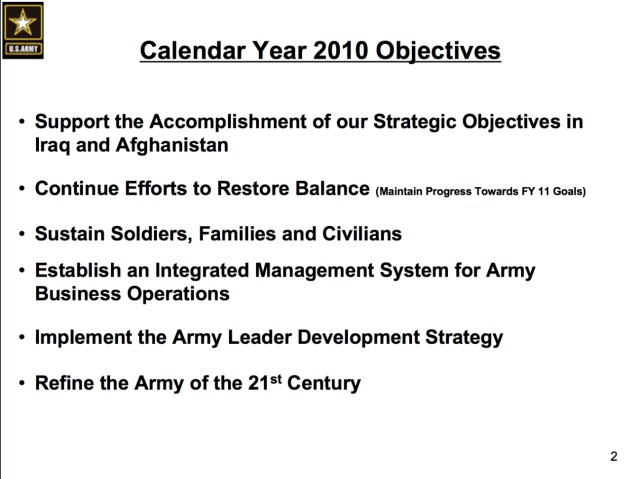
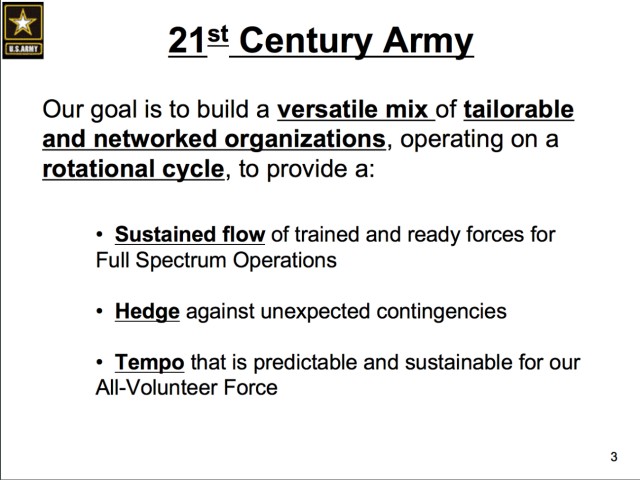
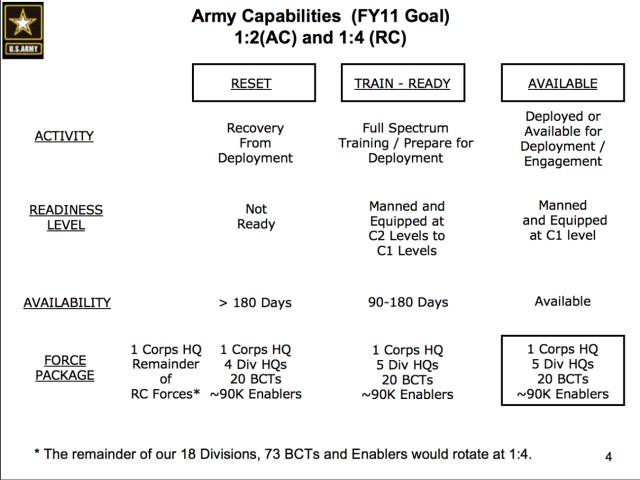
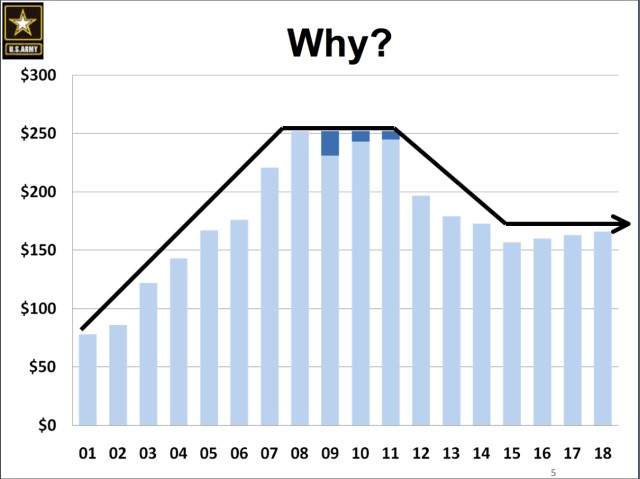

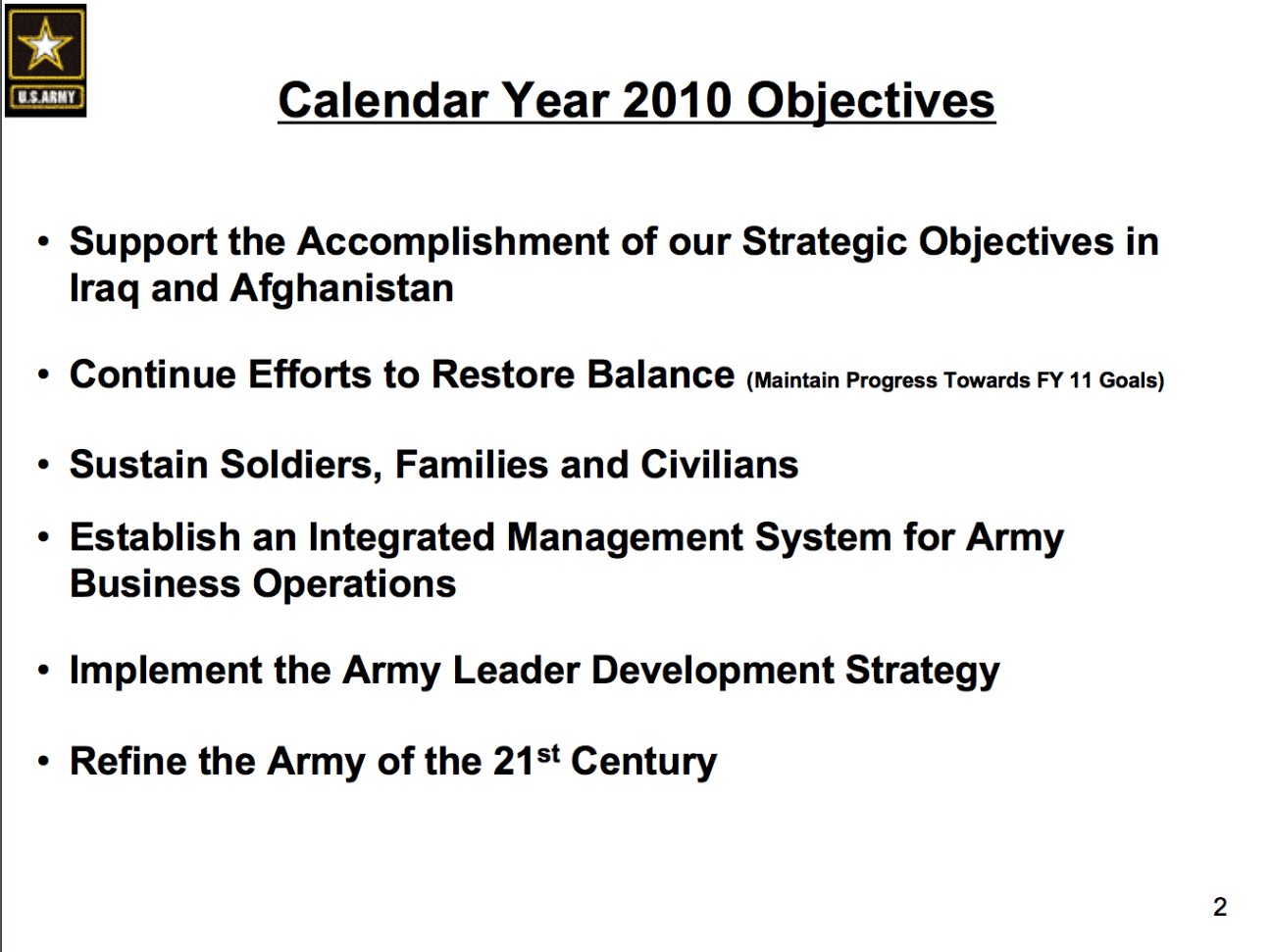
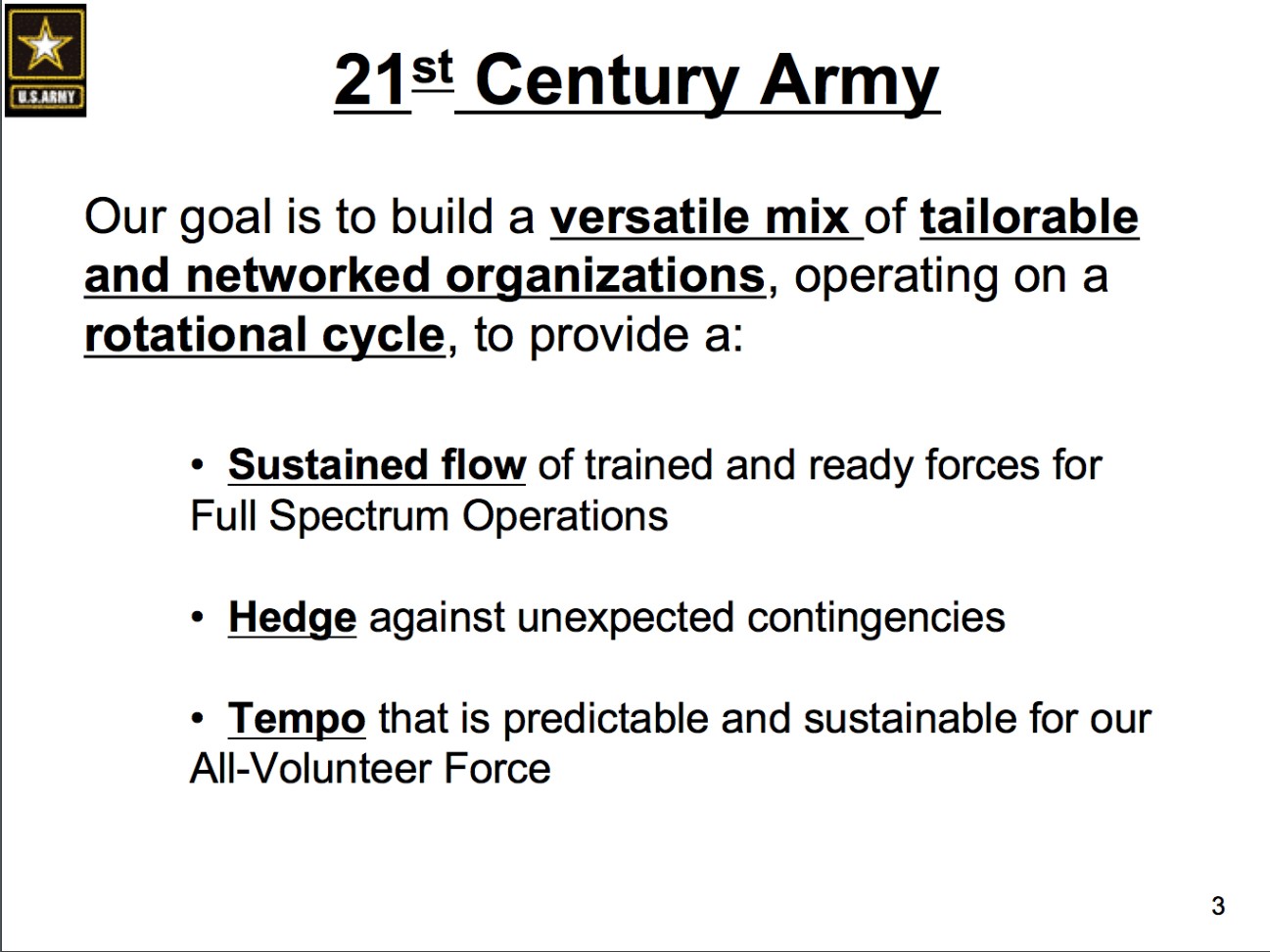
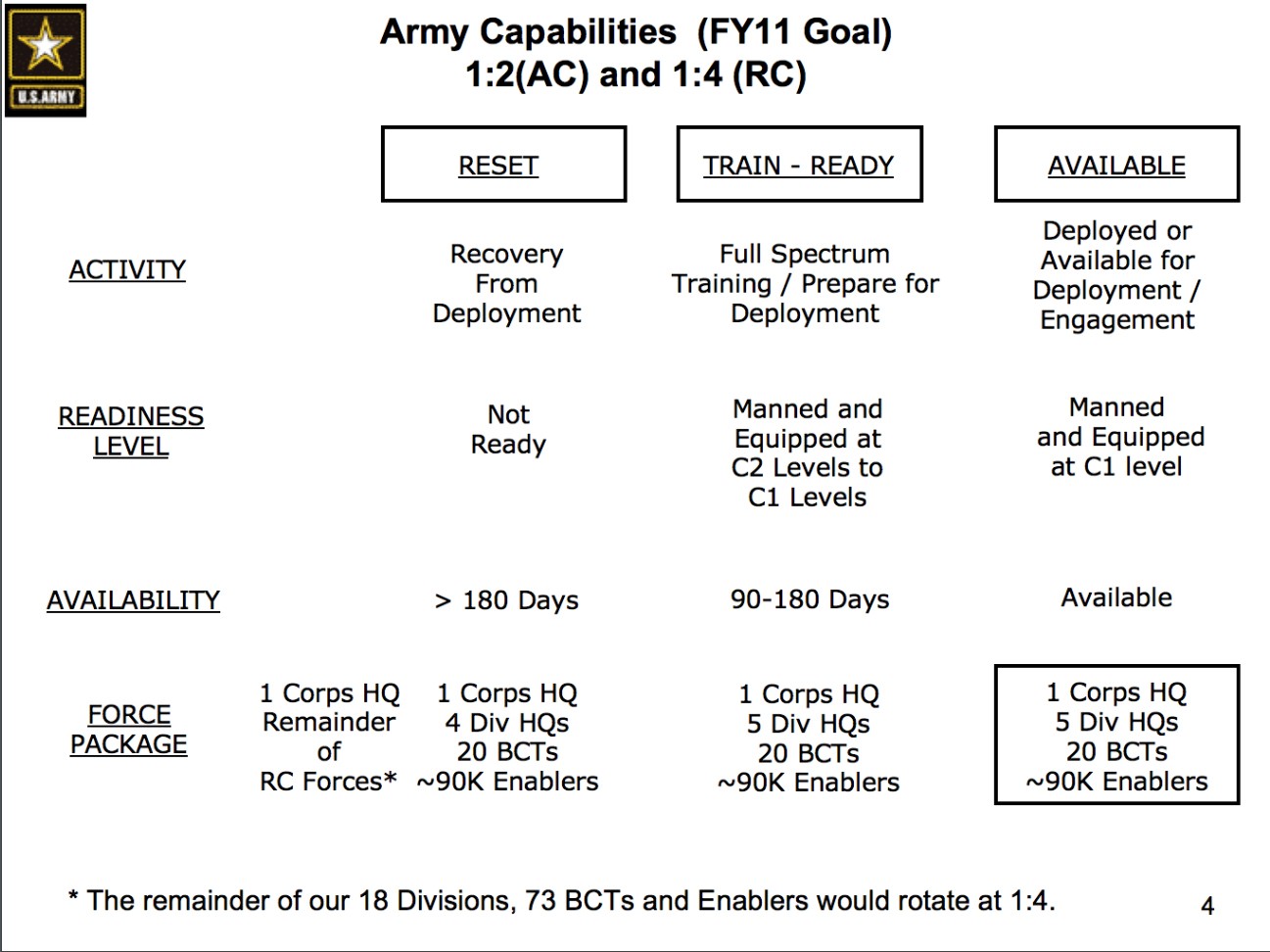
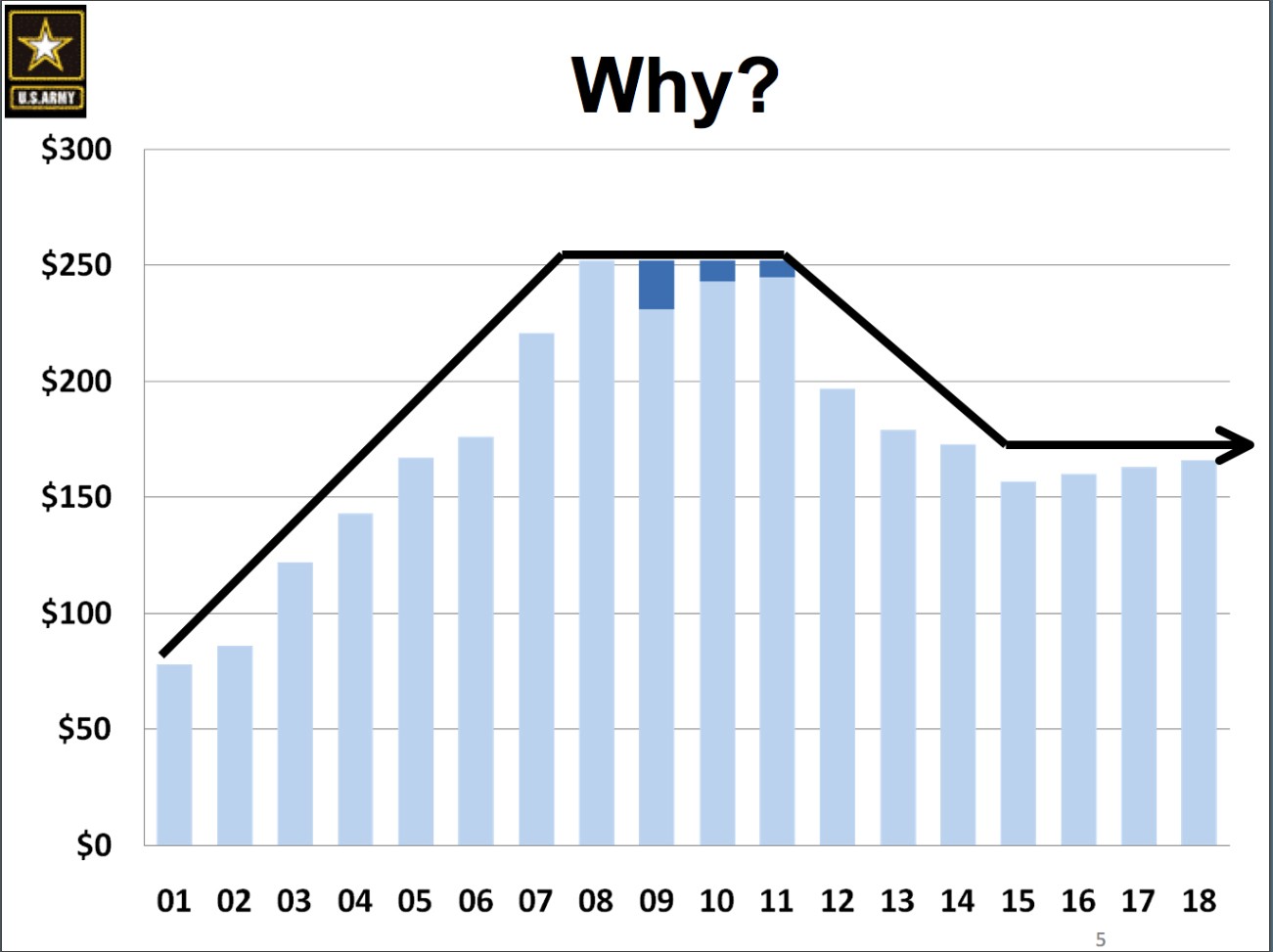
Social Sharing